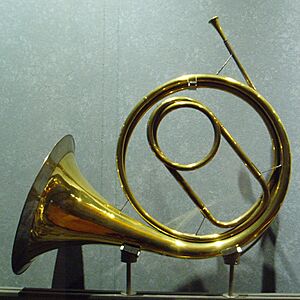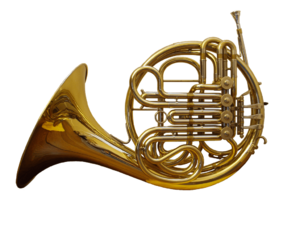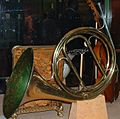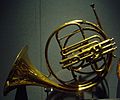Horn (musical instrument) facts for kids
The horn is a type of brass instrument. It got its name because it developed from the actual horns found on some animals' heads. Today, these instruments are often called French horns.
Contents
How the Horn Was Used in Hunting
Long ago, horns were often used during hunting trips. These early brass instruments were shaped in a circle. This design allowed hunters to put their arm through the horn and carry it easily on their shoulder. They could even blow it while riding a horse. Hunters used specific notes to send messages to each other across long distances.
The Horn Joins the Orchestra
In the 17th century, the modern orchestra started to grow and become popular. Orchestras often played music for operas. Operas in those days usually told stories about gods and goddesses or kings and queens. Many of these stories included a hunting scene. To make these scenes sound real, actual hunters were invited to play their horns with the orchestra. This is how the horn became an important part of orchestral music.
A brass instrument usually produces one main note. Players can make a few other notes by changing how much air pressure they use with their lips. Over time, horn players found a clever trick: if they put their right hand inside the bell (the wide, open end of the horn), they could change the main note. This discovery allowed them to play many more different notes.
When Mozart wrote his famous horn concertos, he wrote them for a "hand horn." This meant the player used their hand in the bell to change notes. When a note is played with the hand inside the bell, it sounds a bit different, almost muffled. Because of this, a Mozart horn concerto sounds quite unique when played on a modern horn compared to how it sounded originally.
Another way to change notes on early horns was by using "crooks." These were like extra pieces of tubing that could be added to the horn. The longer the tube, the lower the note. So, adding a crook (an extra circle) would make the horn play a lower basic note.
The Modern Horn: Valves and Sound
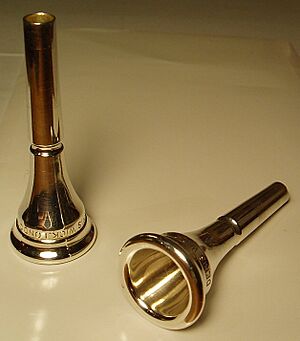
By the 1830s, a new type of horn was invented that had three valves. These valves changed the length of the horn's tubing, making it possible to play all the notes, including sharps and flats. This made the horn a "chromatic" instrument. Composers like Richard Wagner and Richard Strauss then wrote very complex music for the horn. This music would have been impossible to play on the older, valveless horns.
However, some composers still preferred the sound of the natural, valveless horn. For example, Brahms wrote his Horn Trio for piano, violin, and horn, specifically for the natural horn. Also, Benjamin Britten, in his Serenade for tenor, horn, and strings, asked for the horn to be played naturally (without valves) for the opening fanfare. This was to make it sound like a traditional hunting horn.
The horn has a "conical" shape inside its tubing. This means the tube gradually gets wider from the mouthpiece to the bell. (In contrast, a trumpet or trombone has a "cylindrical" bore, meaning the tubing stays the same width). A modern horn has about 6.4 meters (21 feet) of tubing!
The horn makes a beautiful, warm sound. However, it can be quite challenging to play. Its mouthpiece is small, and the "harmonics" (the notes you can play by just changing lip pressure) are very close together. The horn is also a "transposing instrument," usually in F. This means that when a horn player reads a C note, it actually sounds like an F below that written note.
Towards the end of the 19th century, the "double horn" was created. This instrument combined a horn in F with a horn in B flat, giving players even more flexibility.
In the 18th century, orchestras usually had two horns. This number grew to three or four in the 19th century. Today, some large orchestras might even have up to eight horns!
Famous Horn Players You Should Know
- Hermann Baumann (a famous solo player)
- Stefan Dohr (plays with the Berlin Philharmonic)
- Dennis Brain (1921-1957) (played with the Royal Philharmonic and Philharmonia Orchestras)
- Barry Tuckwell (born 1931) (played with the London Symphony Orchestra)
- David Pyatt (plays with the London Symphony Orchestra)
Images for kids
-
A mellophone.


